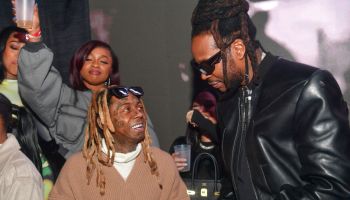There aren’t stories quite like Silvia Via’s that are told in the media or taught in schools to young women as a lesson on how to deal with domestic violence, self esteem, and protecting oneself.
Ironically, however, there are many like Silvia Via. So many, in fact, that the idea that millions of them are silenced by the crushing weight of domestic violence and a society that makes women responsible for men’s actions is as much unbelievable as it is terrifying.
But Via, founder of Boston-area non-profit One Way Treatment, is doing her best to throw out the taboo of staying silent about domestic violence issues by telling her own story and building the confidence that women need to stand tall.
Confidence that she, at one point in her life, lacked tremendously. But to honor Domestic Violence Awareness month, Via sat down with GlobalGrind to talk about growing up in a violent home, getting into her own violent relationships as an adult, overcoming and persevering.
All of which eventually led her on her own journey to support women who had been where she once was with the non-profit that’s both saving lives and using preventative measures to protect young women from domestic violence.
Via’s story starts like many others — growing up in a violent home. But living with her mother and stepfather as a young child in Guatemala wasn’t just detrimental. It nearly killed her.
Tell us about your upbringing:
One of the main reasons I came to this country is because where I grew up in Guatemala, abuse is very prevalent. Physically…sexually..all of it. And my stepfather gave my biological mother an ultimatum because I wasn’t his child. He didn’t accept me. So he did everything from gashing me with glasses to shooting at me when he was drunk, like blatantly trying to kill me.
What was your mother’s response to this abuse?
My mother said, “I feel like this is the best thing to save your life.” And we walked for days to the city to an orphanage. When I finally was adopted and came to this country, my parents couldn’t understand why I constantly got into fights. And all I knew was hitting and hitting. There was always this dark cloud of violence over me.
So that experience, watching domestic violence in your own home, led to domestic violence in your future relationships?
I had a boyfriend and we had similar backgrounds. But he wasn’t what you think about violent men, he was a college graduate. People think of domestic violence as a certain type of demographic. They’re poor people, or they think women who look a certain way…that will never happen to them. But the last straw was in 2008 when he stabbed me.
Towards the end of our relationship, I could see the control issues. He was aiming for my face and I put myself in the fetal position and that’s how he got my knee and my elbow. He ended up taking me to the hospital [and walks into emergency room] saying ‘help me, my girlfriend fell outside.’ But in the car he was beating my head and saying ‘don’t tell anybody this happened or I’ll drop you off at the hospital and go to your mom’s house to kill your mom and daughter.’ That’s when I said, ‘this is enough.’
What happened after that? You had to get out.
Yes I did. It took a lot and I can see why a lot of women stay, because it takes everything in you to walk away. It’s one of the toughest things. I knew in my mind I was going to do it, but it was actually physically harder to actually leave.
That’s the misconception. If you’re not in a domestic violence situation, then you don’t really understand it. But how did the police respond? Did they question the validity of your story because a lot of cases end because of victim-shaming?
The hospital never asked me what happened.
So this is what I want to tell most women, and I think it’s the imperative part. I built my own case. Anytime he left me awful messages, I don’t know why, but I just always saved them. Not like I wanted to, but I just knew something was wrong. I just felt that this guy was a little too controlling. I had witnesses, friends who witnessed things, so right before we went to the police, I started calling my friends and asking them if they remembered his outbursts. So I tried to gather as much information on my side as I could, because if you go there with no evidence and say ‘this happened to me’ they won’t believe. The moment he puts his hands on you, I know it may be hard, but take a picture of it. Save it and maybe you won’t leave him then — but try to gather as much information as possible so when that time comes when you want to leave, you have so much information and you have a case.
When I went to the police, I even showed them my scars, because they grill you. They’re asking you a million questions, “What took so long? Why did it take you two months?” It’s heartbreaking to tell your story…it’s shameful. But at the same time, there’s no better feeling of redemption. You finally told the story of what happened, there’s no greater power. When they say, “The truth shall prevail” they’re speaking the truth, it’s definitely a powerful thing.
So what was the next step in your healing process?
I went to Elizabeth Grady School of Esthetics (upon graduating, Via decided to concentrate on the makeup industry, getting certified in 2010 in camouflage makeup, wedding, media, runway, and print. Via is a certified accomplished makeup artist). That’s where I started to formulate these ideas because I’m looking at my scar and what happened and I wanted to fix that.
Eventually Via started One Way Treatment. It’s a two-part program that helps lift the physical self-esteem in young girls and women.
In the Women’s Program, Via and Una-Via Professionals volunteer by providing services in beauty, fashion and health. The mission is to go into women’s shelters and physically give these abused women a makeover, which lifts their self-esteem. By providing a makeover, fashionable clothes and teaching them how to cover up their scars, it allows them to present themselves appropriately, which can be life changing for their new confident image.
How did you come up with the name “One Way?”
In 2010, I believed the final piece to my puzzle and evolving in life was that I needed to go to Guatemala and find my real mother. So I flew back home and went back to my orphanage where I lived for a year and I had all these soccer donations to give. I wouldn’t be who I am without sports. I had a scholarship to play soccer for CM State.
So this is how the girls program at One Way began. I went to an orphanage and said, “I have these soccer scholarships” and the lady said, “No, girls can’t play sports.” Wait, we’re in 2010? So now I’m shocked…I know what sports did for me. So I was heartbroken. I had to go a boys home and give all of my soccer donations away.
Two weeks go by and I went running in my last days in Antigua. On the street signs I’m seeing “Una Via” and everyone calls me “Via” because my name is Silvia Via, so I took a picture of it and I went home and sent it to my graphic designer. I told him that this was going to be the name of my company and that’s the name of my LLC, One Way Markets Consulting and Branding. So “una via” in Latin means “One Way.” Now that’s the name of my program, because there’s only one way to treat a lady and that’s the right way. I love it. It came from the heart and I think if things didn’t happen the way it did in Guatemala, and I hate to say this, but in a way my abuse from home and from my past was God was saying that I was strong enough and I was going to come back from that and this is what your purpose here is.
Can you talk briefly about your program?
For the girls, I advocate them to participate in sports. I help build their self-esteem through sports, get them in shape and help educate them about violence.
For the women, I take them when they are transitioning out of shelters and relationships. We come together and I tell my story, I help them look for jobs, and help them with their own individual tailored guide with their new look.
Do you find it challenging to talk to girls about domestic violence regarding rape culture and popular culture?
I open up the conversation, because they ask me how I got my scars and that’s how I start. I do have a 13-year-old and I am single mom, so when she asks me “Mommy, what’s Molly” because she hears it in music, I have to explain to her what that is and the consequences. These girls are very impressionable and they need to be aware of their surroundings and socially conscious.
What about bullying? While children are exposed to violence in their homes, they are also being abused at schools and social programs and such forth. Do you tackle that in your program?
It’s verbal abuse. It’s mental abuse. You’re terrorizing my emotions and I find it difficult in this country that we haven’t incorporated this whole mental thing. Let’s call it what it really is. That’s part of domestic violence. They want to call it anti-bullying. No. It’s called anti-domestic violence. Domestic violence is verbal, physical, mental, sexual, all of that combined in one.
There is only one way to treat a lady and that’s the right way.
To read more about Silvia Via’s story, click here.
To learn more about One Way Treatment, click here.
















